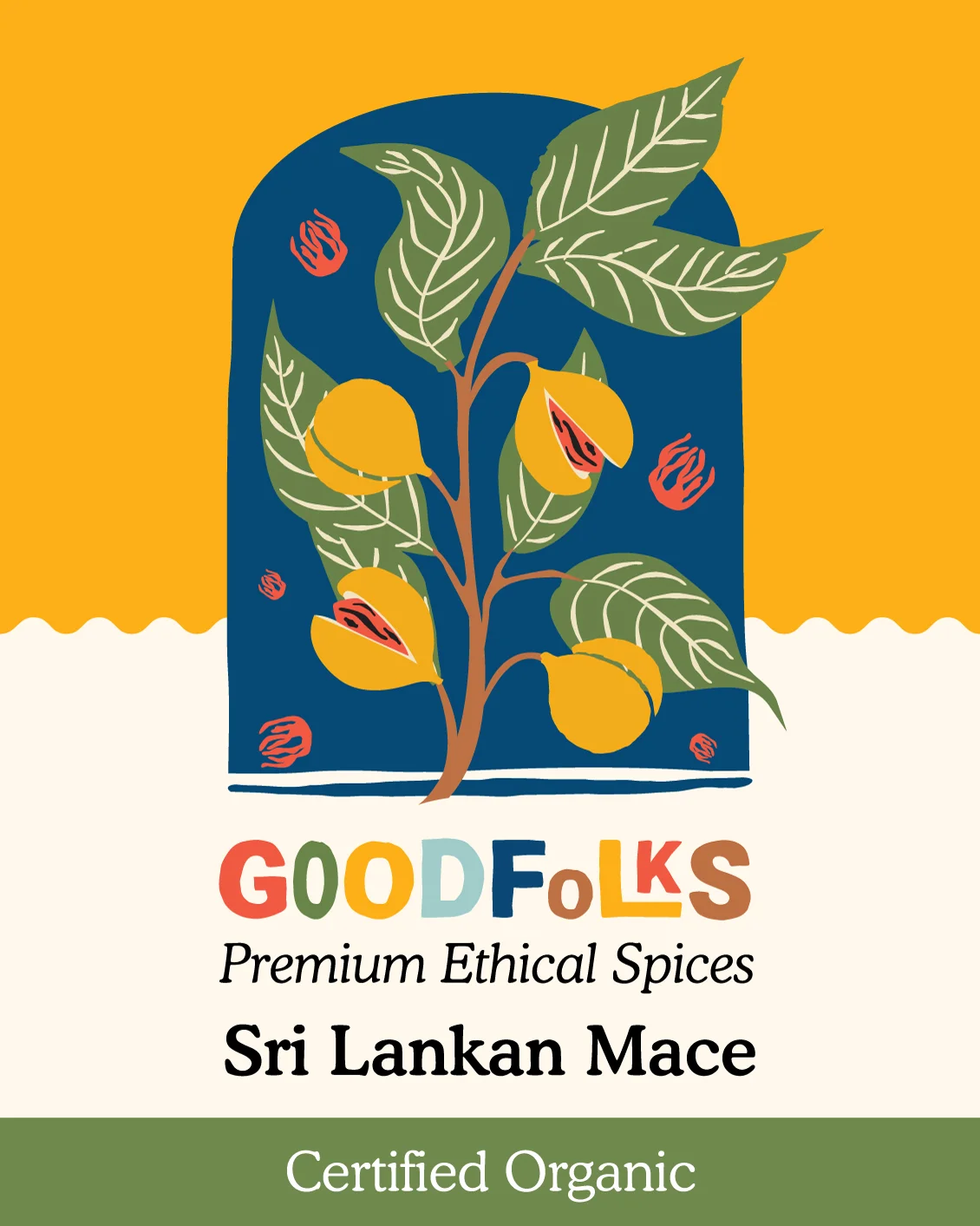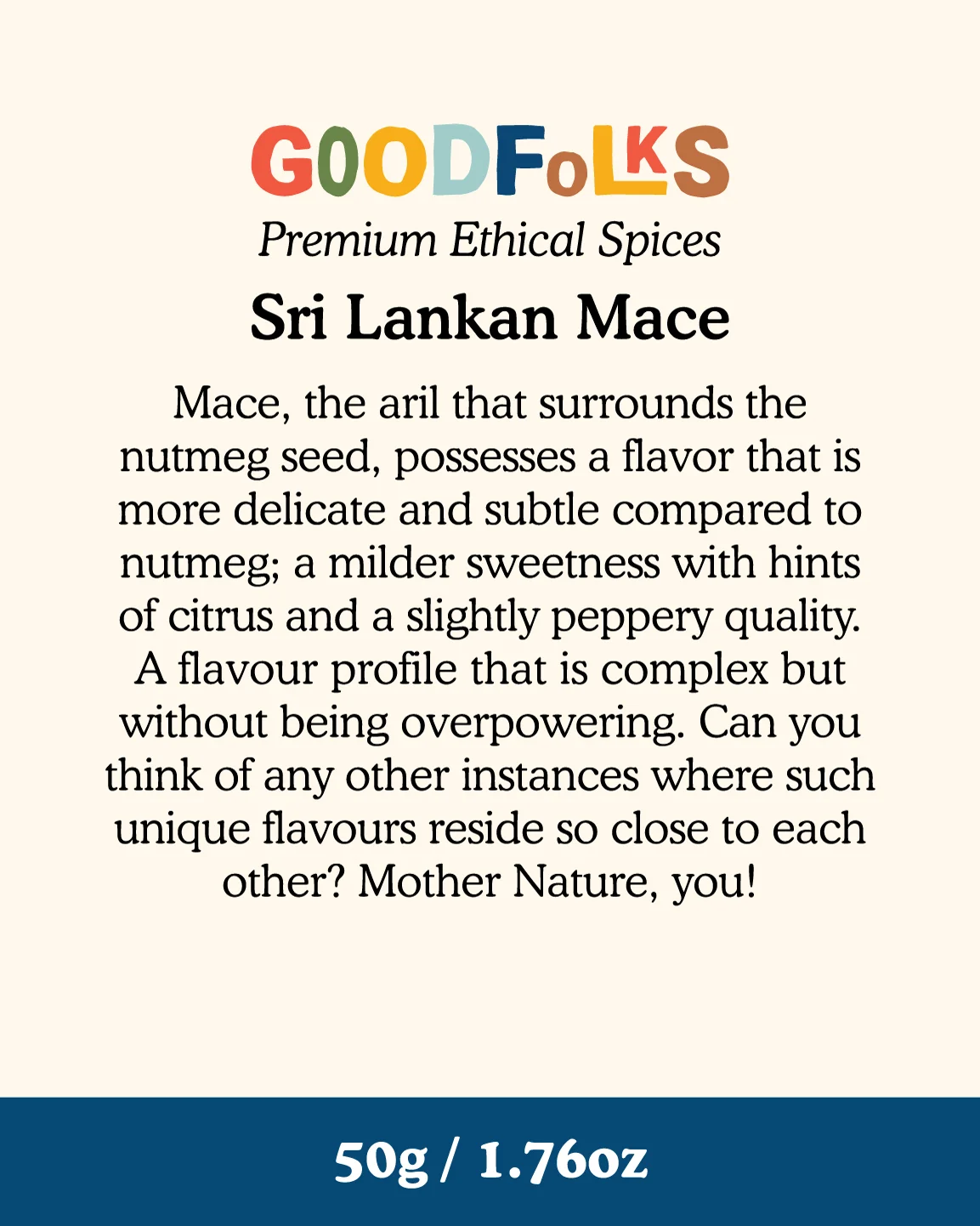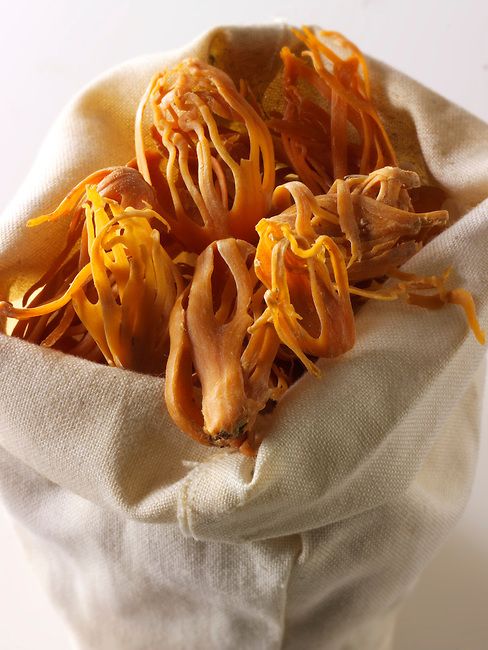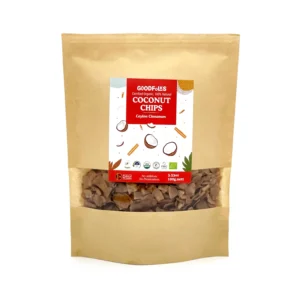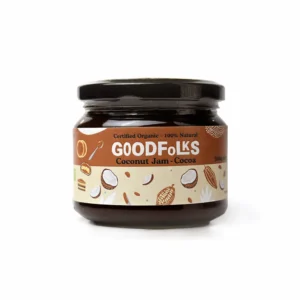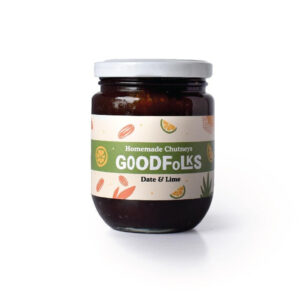Description
What is Mace and how is it different from Nutmeg?
Mace and nutmeg are two spices derived from the same fruit, the nutmeg tree (Myristica fragrans). Mace is the red, lacy aril that surrounds the seed, while nutmeg is the brownish, oval-shaped seed itself. Mace has a delicate flavor with hints of nutmeg, pepper, and citrus, and is used in sweet and savory dishes. Nutmeg, on the other hand, has a warm, nutty taste with spicy and sweet notes, making it a versatile spice for various culinary applications.
Both mace and nutmeg are valued for their distinct flavors and are commonly used in a wide range of global cuisines.
Also see Sri Lanka Organic Nutmeg for more information
The Arrival of Mace to Sri Lanka
Mace (and Nutmeg), like most other spices, was introduced to Sri Lanka in the 9th century by Arab traders. The island’s fertile soil and favorable tropical climate of Sri Lanka resulted in a high quality and flavour profile that makes Sri Lankan Mace highly prized.
Unique Qualities of Sri Lankan Mace Spice
Rich Flavour Profile: Known for its exceptionally rich and aromatic flavor. It possesses a delicate balance of warm, sweet, and slightly spicy notes, making it a prized spice in culinary applications.
Vibrant Colour: Sri Lankan mace is characterized by its vivid, reddish-brown hue when fresh. This vibrant colour is indicative of its freshness and quality.
High Essential Oil Content: Typically contains a higher concentration of essential oils compared to mace from other regions. These essential oils are responsible for the spice’s distinct aroma and flavor.
Careful Harvesting and Processing: Sri Lankan farmers employ traditional, time-tested methods for harvesting and processing mace. This careful attention to detail helps preserve the spice’s potency and quality.
Sustainable Farming Practices: Sri Lanka places a strong emphasis on sustainable agriculture. Many nutmeg plantations in the country utilize organic and eco-friendly farming practices, which can enhance the overall quality of the spice.
Geographical Factors: The specific climate and soil conditions in Sri Lanka’s nutmeg-growing regions contribute to the unique flavor profile of its mace. These factors play a crucial role in determining the quality of the final product.
Cultural Expertise: Sri Lanka has a rich cultural heritage associated with spice cultivation. The knowledge and expertise passed down through generations contribute to the high quality of Sri Lankan mace.
Strict Quality Control Measures: Sri Lanka maintains rigorous quality control standards for its spice exports. This ensures that only the finest mace reaches the global market.
Grades of Sri Lankan Mace Spice
Whole Mace Blades (Grade A)/Special Grade 01 Mace:
This is the highest grade of mace. It consists of intact, unbroken mace blades with a vibrant red color and a well-defined, lacy appearance. Grade A mace is considered to be of the finest quality.
Broken Mace (Grade B)/FAQ Grade 2 Mace:
This grade includes mace pieces that may be smaller, irregular in shape, or have some imperfections. While they may not meet the visual standards of Grade A, Grade B mace is still of good quality and suitable for many culinary applications.
Mace Powder (Grade C):
Mace powder is made by grinding dried mace blades. This grade is convenient for use in recipes and is commonly found in grocery stores. It provides a consistent flavor and is a convenient option for cooking and baking.
How to use Sri Lankan Mace (Spice)
Sri Lankan mace, like nutmeg, is a versatile spice that can be used in various culinary applications to add depth and complexity to dishes. Here are some ways to use Sri Lankan mace:
Infusing Flavour in Soups and Stews:
Add whole mace blades to simmering soups, stews, and sauces. The mace will impart a warm and aromatic flavor to the dish.
In Baking and Desserts:
Grind mace blades into a fine powder and use it in baking recipes like cakes, pies, cookies, and custards. It pairs particularly well with fruits like apples and pears.
In Savory Dishes:
Grate or finely chop mace and use it as a seasoning for savory dishes like meat-based sauces, braised meats, and certain types of curries.
In Rice Dishes:
Add whole mace blades or ground mace to rice dishes while cooking for an aromatic and flavorful twist.
In Beverages:
Infuse warm beverages like mulled wine, spiced cider, or chai tea with a small piece of mace for added depth of flavor.
Homemade Spice Blends:
Incorporate ground mace into homemade spice blends like curry powder, garam masala, or pumpkin spice mix.
Pickling and Preserving:
Add mace to pickling solutions or brines for fruits and vegetables. It can enhance the flavor and aroma of preserved items.
Infused Oils and Vinegars:
Create infused oils or vinegars by steeping whole mace blades in them. This imparts a unique flavor that can be used in dressings, marinades, and as a finishing touch.
Flavoring Creamy Dishes:
Use ground mace in creamy dishes like béchamel sauces, macaroni and cheese, or creamy soups for a subtle warmth and depth of flavor.



